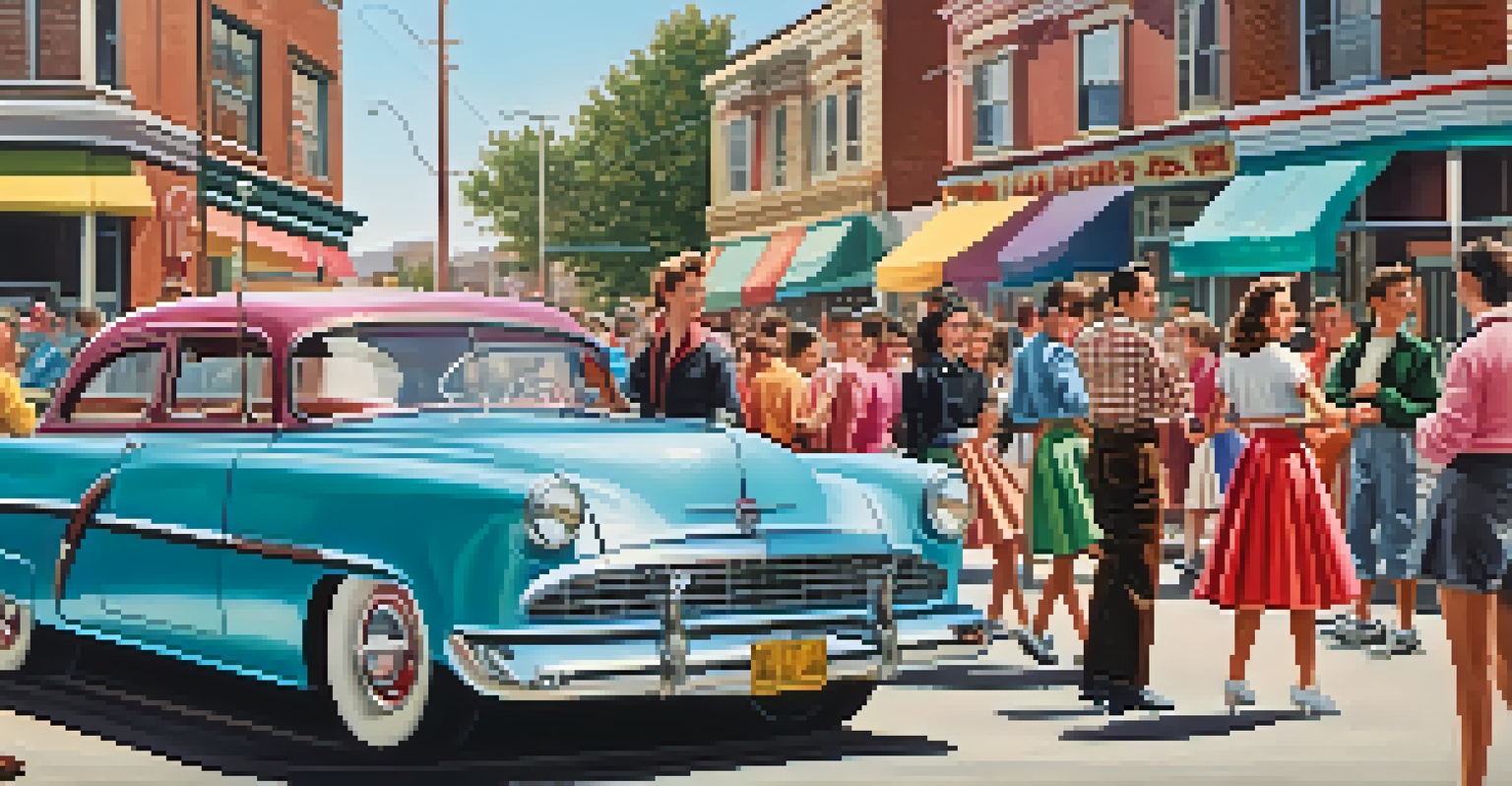The Birth of Rock and Roll: 1950s Music Evolution

The Cultural Landscape of the 1950s
The 1950s were a transformative time in America, marked by post-war optimism and a burgeoning youth culture. This decade saw the rise of the baby boomer generation, which significantly influenced music trends. With teenagers gaining more purchasing power and leisure time, they became a key demographic for music producers and artists.
Rock and roll is a music that is based on the rhythm of the people, a reflection of their lives.
As television became a staple in homes, it introduced new music styles and artists to a wider audience. Shows like 'American Bandstand' showcased emerging talents and helped shape popular music tastes. This cultural shift laid the groundwork for a musical revolution that would soon follow.
The blend of various musical genres, including rhythm and blues, country, and jazz, created a fertile ground for new styles to emerge. The cross-pollination of these genres was crucial in the evolution of rock and roll, reflecting the diverse experiences of American society.
The Influence of Rhythm and Blues
Rhythm and blues (R&B) played a pivotal role in the development of rock and roll during the 1950s. Artists like Ray Charles and Ruth Brown brought the genre to the forefront, combining jazz, blues, and gospel elements. Their innovative sounds captivated audiences and laid the groundwork for future rock artists.

The energetic beats and emotive lyrics of R&B resonated with the youth, creating a sense of rebellion and freedom. This genre's popularity paved the way for white artists to explore similar sounds, leading to a cultural crossover. The blending of these musical styles sparked the creation of rock and roll, appealing to a wider demographic.
Rise of Rock and Roll Icons
The 1950s introduced iconic figures like Elvis Presley and Chuck Berry, who shaped the genre and influenced future musicians.
Moreover, R&B's themes often addressed social issues, which connected deeply with listeners. This connection not only entertained but also inspired changes in societal attitudes, making music a powerful vehicle for expression in the 1950s.
The Birth of Rock and Roll Icons
As rock and roll emerged, several iconic figures helped define the genre. Elvis Presley, often dubbed the 'King of Rock and Roll,' became a cultural phenomenon with his charismatic performances and unique sound. His blend of country, blues, and pop resonated with millions, making him an enduring symbol of the era.
Music is the voice that tells us that the human race is greater than it knows.
Chuck Berry also rose to prominence, known for his guitar riffs and catchy lyrics that captured the spirit of youth. Songs like 'Johnny B. Goode' showcased Berry's talent and laid the foundation for rock guitarists to come. His influence extended far beyond the 1950s, impacting countless musicians in various genres.
Little Richard, with his flamboyant style and energetic performances, challenged societal norms and brought an electric energy to rock and roll. His hits, like 'Tutti Frutti,' showcased a vibrant blend of rhythm and blues that appealed to diverse audiences, cementing his legacy in music history.
The Role of Radio in Rock and Roll's Popularity
Radio was a vital medium for the dissemination of rock and roll music in the 1950s. Disc jockeys played a crucial role in promoting new artists and songs, helping to catapult them into the mainstream. Stations began to cater specifically to youth audiences, creating a dedicated platform for rock and roll.
Programs like Alan Freed's 'Moon Dog Show' showcased the genre and introduced listeners to emerging artists. Freed's promotion of rock and roll helped bridge racial divides in music, bringing together diverse audiences. This accessibility played a significant part in rock and roll's rapid growth and acceptance.
Television Transformed Music Trends
Television shows like 'American Bandstand' elevated rock and roll artists to stardom, connecting fans with performers in a new way.
As rock and roll gained traction, it transformed radio programming by emphasizing the importance of popular music. The shift in focus towards youth culture marked a turning point in the music industry, establishing a lasting legacy for future generations.
The Impact of Television on Music Trends
Television emerged as a powerful force in shaping music trends during the 1950s. Shows like 'American Bandstand' and 'The Ed Sullivan Show' provided platforms for rock and roll artists to perform live, reaching millions of viewers. These televised performances made stars out of musicians, solidifying their place in popular culture.
The visual element of television also played a role in promoting the flamboyant styles of rock artists. Elvis Presley's iconic performances, complete with his signature dance moves, captivated audiences and set a standard for future performers. Television allowed fans to connect with artists on a personal level, enhancing the music experience.
Moreover, the influence of television extended beyond just exposure; it also shaped fashion and lifestyle trends. The blending of music and visual culture laid the groundwork for the multimedia entertainment landscape we see today.
The Evolution of Music Styles in the 1950s
The 1950s were characterized by a fusion of various musical styles that contributed to the evolution of rock and roll. Elements from country music, blues, jazz, and even pop were integrated, creating a rich tapestry of sound. This eclectic mix not only defined rock and roll but also showcased the creativity of the era's musicians.
Artists began to experiment with different rhythms and melodies, pushing the boundaries of traditional music. The use of electric guitars and amplifiers added a new dimension, producing a louder and more vibrant sound. This shift marked a departure from earlier music styles, appealing to a generation seeking something fresh and exciting.
Cultural Impact of Rock and Roll
Rock and roll served as a cultural movement that challenged societal norms and fostered unity across racial lines.
As rock and roll continued to evolve, it inspired countless subgenres, from surf rock to doo-wop. Each style brought its unique flair, further enriching the musical landscape and ensuring the genre's lasting impact.
Rock and Roll's Social and Cultural Impact
Rock and roll was more than just a musical genre; it was a cultural movement that challenged societal norms. The music often addressed themes of rebellion, love, and freedom, resonating with a generation eager for change. This connection between music and social issues made rock and roll a powerful force for self-expression.
The genre also played a significant role in breaking down racial barriers. As African American artists gained popularity, their music crossed racial lines, fostering a sense of unity among diverse audiences. This cultural integration marked a significant shift in the music industry, paving the way for future artists of all backgrounds.

Additionally, rock and roll influenced fashion, language, and youth culture, creating a lasting legacy that transcended music. The rebellious spirit of the genre inspired generations to embrace individuality and challenge the status quo, shaping the cultural landscape for decades to come.